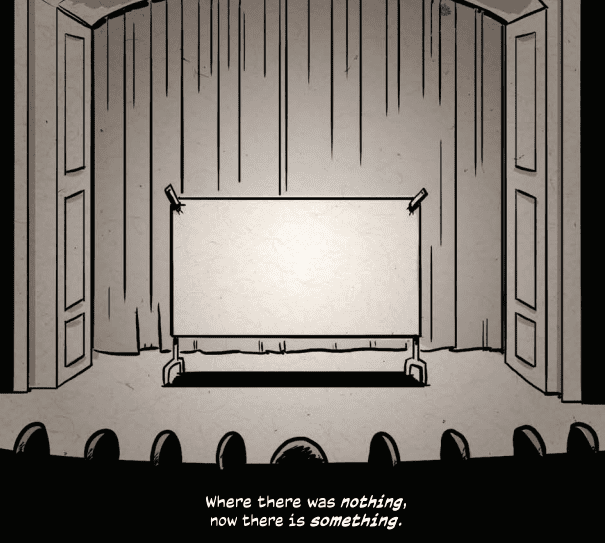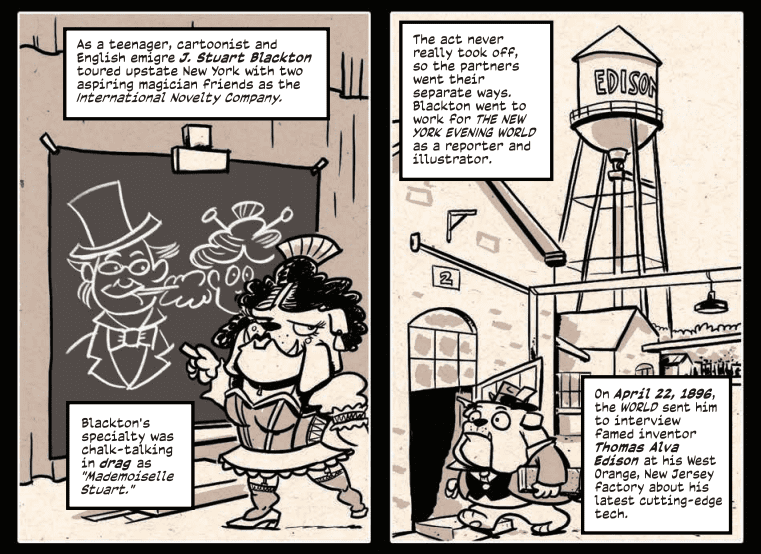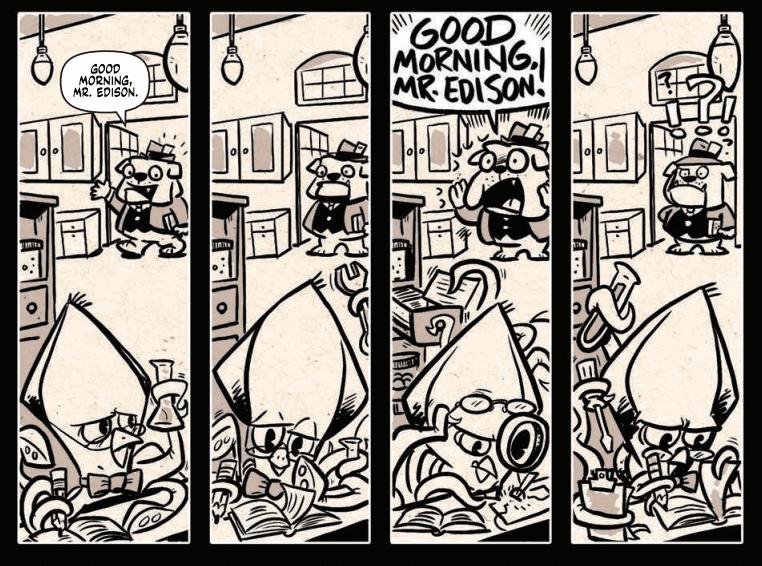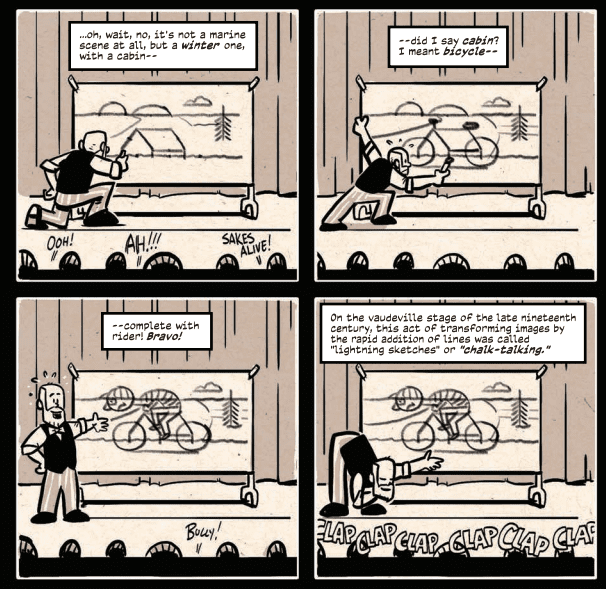Comic books are very adaptable and are able to tell many different types of story in a wide range of styles. It is for this reason that the format is useful for educational purposes with the image and text relationship better at engaging readers quickly and more memorably. This makes the medium perfect for something like IDW Publishing’s new series The Comic Book History of Animation, part one of which is released on 9 December 2020.
Promising to cover the entire spectrum of animation history, the first issue starts in the roots of illustration and searches for the seeds of animation. Fred Van Lente and Ryan Dunlavey have chosen a very informal style of both presentation and narration, firmly establishing a child friendly environment. A quick read through highlights that there is something for everyone on these pages.

Start at the Beginning
Following in the footsteps of Scott McCloud and his Understanding Comics, The Comic Book History of Animation (known as simply History for this point on) reaches into the past to help cement the historical timeline of ‘moving cartoons’. Animation didn’t spring into the world fully formed and Van Lente/Dunlavey have cherry picked moments that led to the creation of the form as it is understood today. These moments focus on the creation of the Art work; performance drawing and Chalk-Talking, which in the modern world would be better understood in relation to an educational environment.
MFR ON YOUTUBE (latest video)
Help us reach 5K Subs!
The focus on the act of drawing does two things for the reader. Firstly, it instantly creates a parallel between Comics and Animation which is a theme that flows through History, even if not explicitly stated. The second thing it does is allow Van Lente to build his narrative from a specific point of view, one that is inherently American. Very little is mentioned of the European advancements in animation technology such as Charles-Emile Reynold’s animation machine which predates any of the narrative in History.
Obviously no-one expects a full account of everything that happened but this point about bias is worth making because of the narrative that unfolds. The question of the author’s reliability is raised and the reader should keep this in mind throughout the rest of the comic. The problem of ‘history’ in a broader term is something that McCloud also had to contend with in his books and some of his work is now being critiqued more closely, opening up the field of Comics. The same should be done with History, with the reader using this comic as a starting point for their own education.

Presentation and Audience
Dunlavey has adopted a ‘Funny Animals’ style for the comic, invoking a rich tradition in both comics and animation. The Funny Animal approach allows him to distance the characters in the narrative from the real historical figures just enough for over the top humour and caricature which is an essential element of this comic. For example, Richard Outcault is depicted as his Yellow Kid character both invoking the comic strip and the creator in one simple drawing. And Walt Disney is drawn with the famous Micky Mouse ears making him instantly recognisable throughout.
Subtle changes in the artwork give the reader an indication of what the animation styles were like, enhancing the narrative element in the caption boxes. This works to the advantage of the comic, making it obvious that there is more going on than a parody of famous animators. The continuous use of the caption boxes as a narrator is also a telling creator choice. Instead of using an avatar to guide the reader through History, Van Lente has chosen a more disconnected voice, reducing the fingerprint of the writer. It makes it easier to sell the narrative, and comic, to a wider audience without a visual lecturer. The voice could come from a peer, a teacher, or even a friend, which makes it more accessible.
One of the failings of the comic, however, is this lack of direction regarding the intended audience. Animation, just like comics, has a reputation for being ‘childish’, often being branded with the moniker ‘just for kids’* and texts like this comic are attempting to escape that.
Unfortunately, there is a mixed message within this comic as it is both for kids and for adults but not in the perfectly merged way of a Pixar movie. The title of this first chapter is Silent… but Deadly which is a juvenile joke that sets the tone for the comic; it is after all printed on the cover. Further such gags are scattered throughout which will bring a smile to your face if you are so inclined to that humour. However, there are also more adult themes blatant within the text. The comic touches on alcoholism, corporate bullying, and pornography. Unlike Horrible Histories, a wonderful series of books that wallows in the murky, but more appropriate, side of history, Van Lente’s comic sways between childish and adult, flipping the reader from funny caricature high jinx into an almost dismissal of the misogyny buried deep within the industry. This makes it difficult to draw the line between farce and reality. Again, the problem in History comes down to the concept of Authorial Integrity.
From a reading experience point of view, there’s little to dislike about History. The artwork is engaging and often more challenging than you might expect. Dunlavey places the heavy textual element comfortably into the panels and creates a pleasant flow for the narrative. In places the images do feel more illustrative than storytelling but then other pages are the complete reverse.
The design of the layouts work especially well for easy accessibility which is surely a requirement as some of the target audience for this comic may not be ‘comics’ fans. This accessibility is also reflected in the Funny Animal motif Dunlavey uses, constantly reminding the reader of the Animation, and Comic, aspect of the historical narrative. History has a style which is used from cover to cover to sell the product in a particular way, to a particular audience.

Conclusion
The cover of The Comic Book History of Animation is fun and that sense of enjoyment travels throughout the pages. Van Lente and Dunlavey have curated a fascinating look at the history of American Animation and presented it in a fun way that draws on lofty Comics traditions of representation and biographical narrative. Scholarly work such as Understanding Comics, and influential comics like Maus are obvious influences and these creators are clearly telling a story that is close to their hearts.
Everyone who reads History will get something out of it and learn something new. The best way to look at this is as an introduction into the history of animation, as if Van Lente is opening the door and beckoning you to go through. Once on the other side it is up to you to discover the greater history of the medium and expand your education.
Most importantly, the art style suits the narrative, even if some of the contrasting tones make it difficult to know who this is aimed at. It will be interesting to see how the series develops, especially from an artistic point of view: will Dunlavey incorporate modern animation styles as the story progresses? Will it become less Funny Animal and more realist or expressionist? Either way, it will definitely be worth checking out.

*There is a much wider discussion around this point in both comics and animation. People argue so vigorously against comics/animation being a children’s medium and yet it is an often overlooked fact that this is exactly how the industries viewed themselves. The ‘kids’ market was, and is, instrumental to the success of both media.

